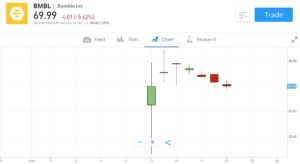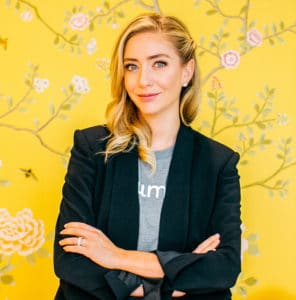How to Buy Bumble Shares UK – With 0% Commission
The dating app Bumble recently made a splash on the NASDAQ. The stock jumped over 60% during its IPO and now has a market cap of over $8 billion.
Bumble enters a crowded field – it’s far from the only platform built for people in search of love. However, there are several reasons to be optimistic about this app’s prospects, including the company’s ambitious and young founder.
Want to buy Bumble stock before it has a chance to take off? We’ll show you everything you need to know about how to buy Bumble shares in the UK and cover why we think this stock is a buy today.
-
-
Step 1: Find a UK Stock Broker to Buy Bumble Shares
The first step in buying Bumble shares is to find a UK stock broker that offers them for trading. Bumble just IPO’d two weeks ago and it trades on the NASDAQ stock exchange, so not every platform has these shares just yet.
That said, two of our top-rated UK brokers are not only offering trading on Bumble shares – they’re also allowing you to trade with 0% commission.
Step 2: Research Bumble Shares
Bumble is a newcomer to the NASDAQ exchange. As with any new stock, it’s important to do your research to find out what’s driving this company’s growth, whether it’s sustainable, and whether the current stock price reflects that future potential.
So, let’s dive into Bumble’s history and financial data to help you decide whether this stock is a buy today.
Bumble Stock Price History & Market Capitalisation
Bumble held its IPO on the NASDAQ stock exchange on February 11, 2021. The company priced its shares at $43, up from an expected range of $37 to $39 before the IPO. Bumble sold 50 million shares, bringing in over $2 billion in new capital.
The company’s shares initially began public trading at $76 per share, a 77% increase over the IPO price available to market insiders. At the end of the first day of trading, Bumble stock closed up 63.5% above the IPO price.
Over the next few days, Bumble stock hit a high of $84.80 per share before falling to retest the $70 level. Today, the shares are trading at $71 apiece and Bumble has a market cap of $8.2 billion.
Bumble EPS and P/E Ratio
Bumble reported a profit of $68.6 million in 2019, but a loss of $84.1 million in 2020 despite notching a 4% increase in revenue year-over-year.
Based on 2019 numbers, Bumble would have an earnings per share (EPS) of $0.29 and a price-to-earnings (P/E) ratio of 119.5. Based on the 2020 loss, Bumble has an EPS of -$0.35.
Bumble Stock Dividend Information
Bumbe has not announced any plans to pay a dividend either this year or in the future. The company lost money in 2020, so it’s unlikely that it will pay a dividend in the next several years.
Should I Buy Bumble Shares?
Bumble shares are currently worth a lot more than the Wall Street bankers who underwrote the IPO thought they were. But that’s hardly a strong argument that Bumble is overvalued – many companies that IPO’d last year exploded in value as soon as they hit the public market, and they haven’t come down yet.
In fact, if anything, we think that Bumble is an undervalued stock. Here’s why.
Bumble’s Revenue Model
Bumble is, above all else, a dating app. The success of this stock will depend almost entirely on the success of the Bumble app – that is, whether it can gain more users and monetize them effectively.
Bumble operates on a ‘freemium’ model, so users can use the app for free but have to pay for a subscription if they want to unlock more advanced features. Right now, around 9% of Bumble’s user base is willing to pay for features.
We like this model because it provides an easy hook for users to make the switch to Bumble, and then keeps them there once they decide to upgrade to a subscription. On top of that, the subscription fees – which are charged weekly rather than monthly – provide excellent cash flow for Bumble. Bumble also has room to bring in more advertising if it needs to boost revenue, although it has reasonably avoided overwhelming users with ads so far.
Bumble’s Market Share
One of the most encouraging things about Bumble is that it’s been extremely fast to take market share away from its closest competitor, Match Group (which owns dating apps such as Tinder and OKCupid). As of last fall, Bumble has more than 12 million active monthly users – up from just 5 million in 2019.
That fast growth can also be a risk, as it shows that a new app in this space can quickly steal market share from established competitors.
However, we think that Bumble’s growth is better attributed to its unique proposition. Bumble requires that women make the first move, and the app has a zero-tolerance policy for sexual harassment and bad behavior. It’s essentially created a safe space for virtual dating, whereas most other platforms feel like the Wild West.
Whitney Wolfe Herd
It’s impossible to talk about Bumble’s prospects for growth without talking about the company’s founder and CEO, Whitney Wolfe Herd. At 31 years old, she’s the youngest female founder to take a company public in the US and one of only a few women to do so.
She’s also a former founder of Tinder, and her experience with sexual harassment at that company has been a big influence in Bumble’s trajectory. When Wolfe Herd talks about keeping Bumble free of harassment and lewd behavior, she means it. Importantly, users know that and it’s a big part of the reason so many are willing to pay for Bumble’s services.
Wolfe Herd is perhaps the reason to be most excited about Bumble’s future growth prospects. She’s young, ambitious, and has a clear vision for how to differentiate Bumble from its competitors. With her at the company’s helm, look for Bumble to continue growing while doubling down on the aspects that have made the platform so popular among users.
The Verdict
Bumble is one of the hottest new stocks on the US market. While it’s pricey, the shares are currently retesting their price floor – which means right now is an opportunity to get in on this dating app stock at a bargain price.
We’re bullish on Bumble’s long-term prospects thanks to the company’s demonstrated ability to turn a profit, its rapid user growth, and the vision of its young founder and CEO.
FAQs
What is Bumble’s ticker symbol?
Bumble trades on the NASDAQ stock exchange under the ticker symbol ‘BMBL.’
What was Bumble’s IPO price?
Bumble shares IPO’d at $43 apiece. However, they began public trading at $76 per share and ended the first day of trading at $70 per share.
Who is Bumble’s CEO?
Bumble’s founder and CEO is Whitney Wolfe Herd. The 31-year old is the youngest female founder to bring a company public in the US and one of only a few female founders of publicly traded companies.
Can I buy Bumble stock in an ISA or SIPP?
Yes, you can buy Bumble shares in an ISA or SIPP. You must find a broker that offers both these account types and trading on US shares. Keep in mind that there are limits on how much you can deposit in an ISA or SIPP each year.
Does Bumble have competitors?
Bumble’s main competitor is Match Group, which owns apps like Tinder and OKCupid. Bumble also competes with Facebook, which has its own dating app.
Is Bumble profitable?
Bumble reported a profit of $68.6 million in 2019, but a loss of $84.1 million in 2020.
Michael Graw
Michael Graw is a freelance journalist based in Bellingham, Washington. He covers finance, trading, and technology. His work has been published on numerous high-profile websites that cover the intersection of markets, global news, and emerging tech. In addition to covering financial markets, Michael’s work focuses on science, the environment, and global change. He holds a Ph.D. in Oceanography from Oregon State University and worked with environmental non-profits across the US to bridge the gap between scientific research and coastal communities. Michael’s science journalism has been featured in high-profile online publications such as Salon and Pacific Standardas well as numerous print magazines over the course of his six-year career as a writer. He has also won accolades as a photographer and videographer for his work covering communities on both coasts of the US. Other publications Michael has written for include TechRadar, Tom’s Guide, StockApps, and LearnBonds.View all posts by Michael GrawWARNING: The content on this site should not be considered investment advice and we are not authorised to provide investment advice. Nothing on this website is an endorsement or recommendation of a particular trading strategy or investment decision. The information on this website is general in nature, so you must consider the information in light of your objectives, financial situation and needs. Investing is speculative. When investing your capital is at risk. This site is not intended for use in jurisdictions in which the trading or investments described are prohibited and should only be used by such persons and in such ways as are legally permitted. Your investment may not qualify for investor protection in your country or state of residence, so please conduct your own due diligence or obtain advice where necessary. This website is free for you to use but we may receive a commission from the companies we feature on this site.
Buyshares.co.uk provides top quality insights through financial educational guides and video tutorials on how to buy shares and invest in stocks. We compare the top providers along with in-depth insights on their product offerings too. We do not advise or recommend any provider but are here to allow our reader to make informed decisions and proceed at their own responsibility. Contracts for Difference (“CFDs”) are leveraged products and carry a significant risk of loss to your capital. Please ensure you fully understand the risks and seek independent advice. By continuing to use this website you agree to our privacy policy.
Trading is risky and you might lose part, or all your capital invested. Information provided is for informational and educational purposes only and does not represent any type of financial advice and/or investment recommendation.
Crypto promotions on this site do not comply with the UK Financial Promotions Regime and is not intended for UK consumers.
BuyShares.co.uk © 2025 All Rights Reserved. UK Company No. 11705811.
We use cookies to ensure that we give you the best experience on our website. If you continue to use this site we will assume that you are happy with it.OkCookie PolicyScroll Up
 Bumble is a newcomer to the NASDAQ exchange. As with any new stock, it’s important to do your research to find out what’s driving this company’s growth, whether it’s sustainable, and whether the current stock price reflects that future potential.
Bumble is a newcomer to the NASDAQ exchange. As with any new stock, it’s important to do your research to find out what’s driving this company’s growth, whether it’s sustainable, and whether the current stock price reflects that future potential.

 It’s impossible to talk about Bumble’s prospects for growth without talking about the company’s founder and CEO, Whitney Wolfe Herd. At 31 years old, she’s the youngest female founder to take a company public in the US and one of only a few women to do so.
It’s impossible to talk about Bumble’s prospects for growth without talking about the company’s founder and CEO, Whitney Wolfe Herd. At 31 years old, she’s the youngest female founder to take a company public in the US and one of only a few women to do so.